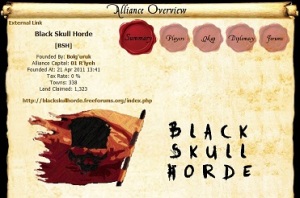Whether it is, or is not, possible to resolve disputes in Illyriad through justice and fairness is something that will be decided by the biggest alliances, and so by the biggest players. If they want to resolve disputes through superior firepower, then that’s what they will do. But for anyone interested in attempting to use justice to settle resource disputes, the following may be of interest.
The first of these is the Voice of The North Accord which was agreed between several northern alliances as a way to resolve resource disputes when the gatherable resources were first released in Illyriad. This worked perfectly. The signatory alliances completely avoided violent disputes in northern Wolgast. However, there is no enforcement mechanism – people have to want this to work for it to do so, and it’s notable that elsewhere on the map res patches were often held or won by force or threats.
The second is the Law Code that I was developing subsequent to this, while I ran the Lords of Frost. I never released this publicly, as I feared aggressive alliances attempting to “game” the system, but it deals with questions of how res patches can be dealt with further down the line, when people start settling new towns near to them. It could probably do with improvement – it hasn’t been field-tested thoroughly – and there are also some fringe issues which need to be resolved (e.g. based around high-yield sites becoming strategically important to an alliance), but it is a start which should suit the majority of resource disputes.
– – –
THE RULERS OF THE FAR NORTH AGREE AND ASSERT, WITH ONE VOICE, THAT
Any new resources which have appeared or shall appear in the north of Wolgast and its immediately bordering lands, are and shall remain the property of the Alliances and rulers who now hold those lands.
Resources on and in the mountains and valleys of of the north east shall remain property of Camelot, Woodland Realm, and any other rulers presently occupying these lands. Resources on and in the frozen wastes and surroundings of north west Wolgast shall remain property of the Lords of Frost. The lands of ResistanceisFeasible to the south of these shall remain property of RiF. Those in and surrounding the valley of the Knights of the Realm shall remain property of the Knights.
Nothing in the above shall imply that these Alliances, nor anyone else, shall have the right to disturb other rulers who already hold lands in this region. All rulers here present shall enjoy peaceful possession of resources close to their settlements. It is noted that Absabroke, Eagles Eyrie, the Crows alliances, and others have members in these areas, who are in no way denied any rights by this.
It is assumed that ownership of resources shall be determined by clear natural boundaries (such as rivers, the edges of mountain ranges, etc.), and where there is no clear and obvious division it shall be that rulers may enjoy ownership of resources within 10 squares of their towns. (Where two towns are within 20 squares of each other, each shall own the resources closest to them.) This shall be true regardless of the Alliance to which a ruler belongs.
No ruler, whether of Camelot, Crows, EE, RiF, Frost, Absaroke, Woodland Realm, or any other alliance, should be denied peaceful enjoyment of their resources.
The following rulers of the north shall uphold one and others’ rights, and provide aid as needed to enforce these rights, including, if required, military action: Camelot, Knights of the Realm, Lords of Frost, ResistanceisFeasible, Woodland Realm.
– – –
LAW CODE
Where Player A has a res patch within 10 squares of his town, and Player B subsequently settles closer: Player A continues to own the site while s/he remains an active player. If Player A ceases to play actively, then the site passes to Player B. Player A’s alliance, alts and friends have no right to exploit the site after Player A ceases to play.
Where Player A has camped on and is exploiting a res patch which is not within 10 of anyone’s town, and Player B then settles a town within 10 squares of that: Player A will cease camping the site, and will cease harvesting, immediately if asked to do so by Player B. Player B then owns the site, but will pay one week’s full production from the site (or equivalent in market value in gold) within one month.
Where Player A has been exploiting a site which is not within 10 of anyone’s town, but has not camped it, and Player B then settles a town within 10 squares of that: Player B owns the site, and need not pay compensation.
Where Player A owns the site, but Player B is also within 10 squares but further away: when Player A ceases to play actively, the site passes to Player B. Player A’s friends, allies and alts shall have no claim over it.


